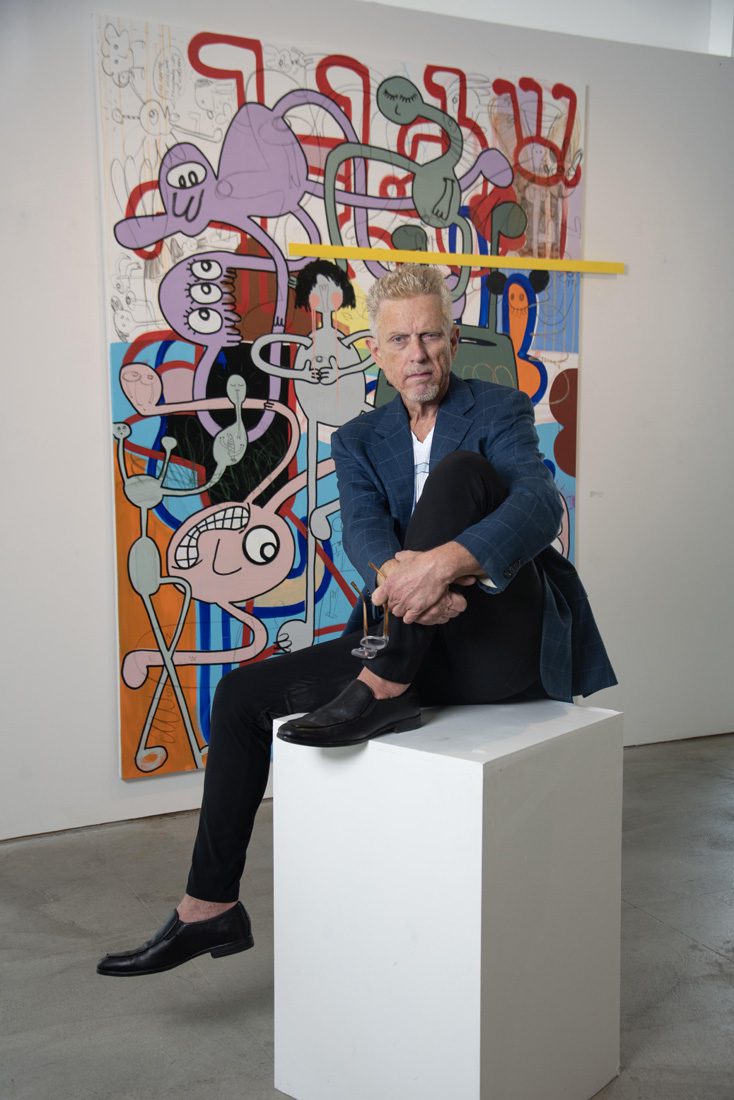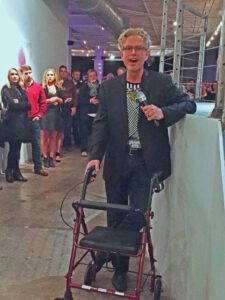Alan Avery fought his way back from a fatal bacterial infection!

Buckhead gallery owner Alan Avery of Alan Avery Art Company attended a family reunion on the shores of North Carolina in August 2016. A news story on NPR talked about bacteria in the ocean, so he and his husband, Michael Newton, followed its advice to check their bodies for any cuts before they went in and thought nothing further of it. A week later, after Avery returned to Atlanta, he began feeling flu-like symptoms. That’s when things got weird.
Avery began to think someone was trying to break into his house. He was so paranoid that he nailed windows shut and called the police five times over the course of two days.
“In hindsight, I have now learned that it was the proverbial Grim Reaper trying to break into my house and my brain’s way of surviving by keeping him out,” Avery says of the hallucination.
The fifth time the police showed up, the officer recognized him from his call the day before and began asking more probing questions about drugs, mental health and infection, as she noticed some bleeding on his leg. With Avery’s consent, the paramedics arrived to give him a drug test that came back clean. He doesn’t remember refusing to go to the hospital for treatment. The officer called his husband, who was across town, to explain her concern for Avery and to suggest he return home quickly.

When Newton arrived, Avery was talking to a friend who wasn’t there. Then his eyes rolled into the back of his head, and he began bleeding profusely. He was rushed to Emory University Hospital where the head of urology immediately diagnosed him with necrotizing fasciitis in his abdomen. The rare yet highly aggressive skin and soft tissue infection is commonly thought of as a “flesh-eating disease.” If not quickly treated, it can lead to sepsis, which is what Avery was experiencing. He later discovered his case was caused by Vibrio vulnificus, a bacterium that naturally inhabits warm coastal waters around the world and can be contracted not only through seawater but by consuming raw or undercooked shellfish, particularly oysters.
What happened next was nothing short of a miracle. The surgical team at Emory performed five live-saving surgeries in 24 hours to remove all infected flesh to stop the infection’s spread. During this process, Avery was put into a coma and given a life-saving combination of IV drugs to move blood away from the extremities to keep vital organs alive, a process that often leads to the loss of extremities. After being in a coma for a couple of months, he flatlined three times coming out of it.
It’s incredibly rare for anyone with Vibrio in their abdomen to live, as a large portion of the lymphatic system is located in that area and can cause bacteria and infection to spread quickly. “I have more to do I guess!” Avery says.
Once back home, Avery was on a wound VAC, usually given to burn patients, for a year and underwent an excruciatingly painful process of every-other-day bandage changes by three nurses for seven hours. His daughter, Ayn Remillard, stayed by his side for support (and later returned to medical school to become a registered nurse with interests in emergency and wound care).

“It felt like I was being skinned alive. I could see down to my organs; that’s how much flesh the surgeons had removed. As your skin grows back, it grows into the bandages,” Avery says.
He has since had 32 corrective operations, including skin grafts and multiple eye surgeries to save his eyesight from narrow-angle glaucoma, a residual problem along with short-term memory loss. Doctors and researchers, including those from the Centers for Disease Control and Prevention and the World Health Organization, continue to study Avery’s case because of his atypical outcome of survival with all of his extremities intact.
With sky-high out-of-pocket medical bills, another miracle ensued. In 2016, the now-late artist Todd Murphy rallied the arts community in one social media post to support Avery, a 42-year fixture in the Atlanta art scene. The Westside Cultural Arts Center put on a benefit that raised in one full night almost enough money to pay all of Avery’s bills.

“It was very humbling and changed who I was and how I saw people,” he says.
At first in a wheelchair as he learned to walk again, Avery returned to work in 2018 not only as a gallery owner but as a patient advocate. He became an advisory board member at Grady Memorial Hospital, where he went for skin grafts at its world-renowned burn center, to encourage better patient care practices.
In 2021, battling PTSD but amongst 200 people cheering him on, Avery got back into the ocean. “The only way to get through a traumatic experience is to walk through it. By sharing my story, I hope my scars become someone else’s sign of hope and that they also can and will live, like I did.”
Words to live by.
ALAN AVERY ART COMPANY
404.237.0370
alanaveryartcompany.com
@alanaveryartcompany
PHOTO: Joann Vitelli
Managing Editor and Wellness Columnist at Simply Buckhead. Blogger at Badass + Healthy.
















